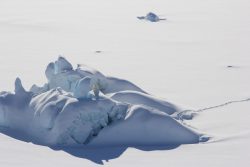
In a rapidly changing Arctic, one area might serve as a refuge — a place that could continue to harbor ice-dependent species when conditions in nearby areas become inhospitable. This region north of Greenland and the islands of the Canadian Arctic Archipelago has been termed the Last Ice Area. But research led by the University of Washington suggests that parts of this area are already showing a decline in summer sea ice.
Last August, sea ice north of Greenland showed its vulnerability to the long-term effects of climate change, according to a study published July 1 in the open-access journal Communications Earth & Environment.
“This area has long been expected to be the primary refuge for ice-dependent species because it is one of the last places where we expect summer sea ice to survive in the Arctic,” said co-author Kristin Laidre, associate professor at the School of Aquatic and Fishery Sciences and principal scientist at the UW Applied Physics Laboratory.
How the last ice-covered regions will fare matters for polar bears that use the ice to hunt for seals that use the ice for building dens for their young, and for walruses that use the ice as a platform for foraging.
The study focused on sea ice in August 2020 in the Wandel Sea, an area that used to be covered year-round in thick, multiyear ice.
Read more at UW News »
